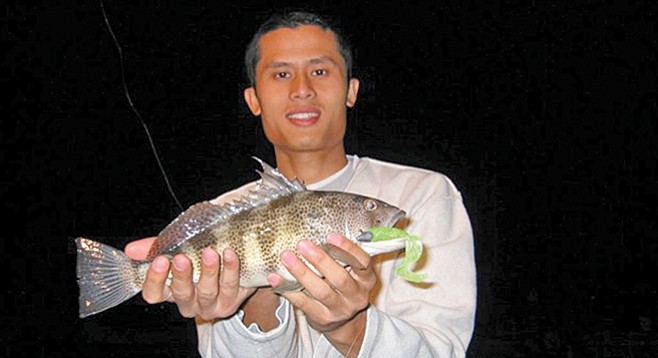 Facebook
Facebook
 X
X
 Instagram
Instagram
 TikTok
TikTok
 Youtube
Youtube

A bucket — blood-stained rag hanging out — was making a racket as a ten-inch mackerel whacked the sides. It would be back in the water as soon as Cesar (not his real name) pinned it on a Carolina rig and sent it flying out into the channel to tempt a big something to bite. Cesar was happy with the catch he’d made. It was midnight.
“You gotta use, like 25-pound test with these,” he said after he’d casted and settled his bait and set the clicker on the old Penn 500 reel. He shrugged at a shovel-nosed sand shark, gills pumping as it lay freshly caught. “These guys, they pull hard and steady. You have to use the gaff, or you’d never get a good one up.”
He picked up a treble hook and started winding up the ¼˝ nylon rope. “Guys have worked together with two, three of these and lifted sharks weighing 100 pounds,” he looked up. “Threshers, up in L.A., they do it every year. Imperial Beach, too. Big shovel-nose, bat rays, all the good stuff.”
I ask him about eating these fish, especially the bottom-dwellers, from the bay. “They are excellent eating! Like all things, too much can’t be good, but we [he and his wife] see nothing wrong with a meal or two a week.”
How do you prepare a ray or sand shark? “With the rays, you cut and skin the wings. You can grill or bake them. Make fake scallops and sauté it. Fry it…it doesn’t matter. With the sand sharks, you take the tail straps to the back. These, too, are boneless and can be prepared to taste. Some make ceviche. Some barbeque it. Some fry it.”


A bucket — blood-stained rag hanging out — was making a racket as a ten-inch mackerel whacked the sides. It would be back in the water as soon as Cesar (not his real name) pinned it on a Carolina rig and sent it flying out into the channel to tempt a big something to bite. Cesar was happy with the catch he’d made. It was midnight.
“You gotta use, like 25-pound test with these,” he said after he’d casted and settled his bait and set the clicker on the old Penn 500 reel. He shrugged at a shovel-nosed sand shark, gills pumping as it lay freshly caught. “These guys, they pull hard and steady. You have to use the gaff, or you’d never get a good one up.”
He picked up a treble hook and started winding up the ¼˝ nylon rope. “Guys have worked together with two, three of these and lifted sharks weighing 100 pounds,” he looked up. “Threshers, up in L.A., they do it every year. Imperial Beach, too. Big shovel-nose, bat rays, all the good stuff.”
I ask him about eating these fish, especially the bottom-dwellers, from the bay. “They are excellent eating! Like all things, too much can’t be good, but we [he and his wife] see nothing wrong with a meal or two a week.”
How do you prepare a ray or sand shark? “With the rays, you cut and skin the wings. You can grill or bake them. Make fake scallops and sauté it. Fry it…it doesn’t matter. With the sand sharks, you take the tail straps to the back. These, too, are boneless and can be prepared to taste. Some make ceviche. Some barbeque it. Some fry it.”
Comments